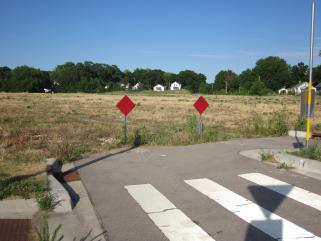







But the city, who now owns the property known as Union Corners, recently pushed to move development forward. According to Don Marx, manager in the Office of Real Estate Services for the city, growing interest in the site started the forward momentum.
“There really hasn’t been much of a market,” said Marx. “Recently we’ve had some more interest expressed on the parcel [at Union Corners] and so the mayor went and told us to go ahead and put it out.”
On June 15 the Economic Development Division of the City of Madison released a Request For Proposals detailing the vision and guidelines for the property. The RFP asks prospective developers to create a plan and bid for the site. The plan must consider the city’s vision and the preferences of various community groups.
The city hopes the developer will honor the site’s history as the home of members of the Ho-Chunk Nation and a gathering spot for Union soldiers during the Civil War. The site should also include green, public and private spaces. The city refers all developers to neighborhood groups who have contributed their own vision for the space.
One such group, Friends of Union Corners, created a Community Benefits Agreement in 2010 with the cooperation of 11 different neighborhood associations. The Agreement lays out what people in the area want and need in such a large mixed residential and commercial space.
Joe Mingle, co-founder of Friends of Union Corners, explained “the goal of a Community Benefits Agreement is to make sure that if a piece of property is being redeveloped and it has a significant amount of public money involved, then the needs of the community should be involved in the conversation about what the development should look like.”
Friends of Union Corners came together in 2009, a few years after a previous development plan fell through due to the recession and declining housing market. The land was repossessed from the previous developer (McGrath Associates) and subsequently sold to the city, explained Dan Rolfs, community development projects manager for the city.
The city hopes to keep the three plots together. But before 2504, 2507, and 2340 Winnebago Street are sold again, community members are hoping to have their say in the redevelopment.
“[We want to] list all the things that people in the neighborhoods around the site want, so that when the developer emerges to start a project here, we can show them what people already are hoping will be there,” Mingle says about the Agreement.
Mingle and his group have been specific about what they want and what they do not want to see in the proposals.
“We don’t want strip malls. We don’t want big parking lots,” said Mingle. And if the proposal doesn’t take the Community Benefits Agreement into account, “they can expect that someone in the neighborhood will protest,” he said.
But Friends of Union Corners and the East Isthmus Neighborhood Planning Council know what they do want. Their members want a grocery store, LEED or green certified structures, and on-site housing that could support the needs of elderly residents, since the East side does not have much housing to accommodate seniors.
The city refers all developers to the Friends of Union Corners Agreement and various other neighborhood plans. The city and the neighborhoods generally align in their vision for the site, including the desire for green space, and accommodation for bikes and pedestrians. The Common Council will ultimately determine which proposal will move forward. Nearby residents can liaise through their alders or attend Council meetings if they object to the decision.
Developers must submit proposals by July 27. The city hopes to select a proposal by August. But Rolfs admits that choosing a developer is the first of many steps before building can actually begin.
If the Community Benefits Agreement plays a large role, Mingle sees the next steps as a three-way negotiation between the city, the community, and the developer. Though, he said, “[it is] hard to predict how the process will go.”
But Mingle is optimistic about the process, since “not much of [the Agreement] is very controversial.” Friends of Union Corners wants to support the development of the space, not challenge it.
If the city and developer can follow some of the suggestions in the Agreement, for example senior living and a grocery store, “people [in the neighborhood] will go crazy. They’ll be thrilled,” said Mingle.
|
|
|
Welcome to the Madison Commons, a website designed to provide news and information about all of Madison's neighborhoods and a crossroads for the discussion of community issues. The name comes from the idea of a village commons, a place for news, talk, debate, and some entertainment, too, that's open to everyone.
All rights reserved. Read more about the Madison Commons and its partners.

